Ottoman Turkey Iznik pottery sold at Christie's London, 28 October 2021
Lot 86. An Iznik pottery jug, Ottoman Turkey, circa 1580; 9in. (22.8cm.) high. Price realised GBP 106,250 (Estimate GBP 40,000 - GBP 60,000). © Christie's Images Ltd 2021
The accentuated baluster body decorated in cobalt-blue, green and bole-red on white ground with blue fish-scale motifs, overlaid by alternating red lobed panels and green and red cintamani motifs.
Provenance: Purchased by present owner in 1980.
Note: The use of elegant fish-scale pattern which covers the ground of this jug is first found decorating a vessel in the form of a fish in the Benaki Museum in Athens which dates to the 1520s (inv.no.10; Nurhan Atasoy and Julian Raby, Iznik, the Pottery of Ottoman Turkey, London, 1989, p.106, no.451, pl.124). The scale pattern was probably inspired by early 16th century Deruta majolica although its use can be seen in Islamic art on a 15th century twin dragon headed candlestick from Khorasan in the David Collection (Kjeld von Folsach, Islamic Art, Copenhagen, 1990, p.207, no.346). In the late 1570s and 80s it became popular to enliven the background of vessels with fish-scale motif, as seen here. On our jug, the fish-scale is used with another popular motif, cintamani roundels. In Ottoman Turkey that motif appears mainly on textiles but occasionally on Iznik pottery and represents power, force and courage. Cintamani roundels were sometimes seen grouped with pairs of wavy lines as can be seen in a similar jug formerly in the Lagonikos Collection, Alexandria (J. Carswell, Iznik Pottery, London, p.83, fig.62). The three circles however appear more often on their own as on this fine example. The combination of fish-scale and cintamani is found on a jug in the Gulbenkian Collection (inv.no.795; Maria Querios Ribeeiro, Iznik Pottery, Lisbon, 1996, p.215, no.70).
Lot 69. An Iznik pottery dish, Ottoman Turkey, circa 1565; 11 1/8in. (28.1cm.) diam. Price realised GBP 100,000 (Estimate GBP 30,000 - GBP 50,000). © Christie's Images Ltd 2021
The white ground decorated in cobalt-blue, bole-red and turquoise with four blue tulip sprays divided by foliate motifs, the cusped rim with stylised 'wave and rock' design, the exterior with alternating rosettes and paired tulips, old collection label to rim, a drill hole to the rim and foot, small crack to the rim.
Provenance: Victor Adda, Alexandria and Rome (d.1965) and thence by descent.
Note: In the 1560s, Iznik painters experimented with arrangements and compositions of typical floral motifs and colour variations with a view to enriching the decorative scheme of their pottery, particularly playing with symmetrical compositions of floral sprays (Nurhan Atasoy and Julian Raby, Iznik, The Pottery of Ottoman Turkey, London, 1989, p.234).
The symmetrical arrangement of four floral sprays found is a less common composition only found on a small group of Iznik dishes. An Iznik dish decorated with a quatrefoil motif composed of tulips alternated with cobalt-blue roundels is in the Ömer Koç Collection (Hülya Bilgi, The Ömer Koç Iznik Collection, Istanbul, 2015, pp.320-1, no.132) and another was sold in these Rooms, 1 April 2021, lot 80, although both of these example employ red tulips rather than the striking cobalt-blue found here.
Moreover, the flowers decorating this dish are drawn on a much smaller scale and with greater control than the dishes of comparable design mentioned above. This dish rather shares its unusually fine drawing with a jug sold in these Rooms, 21 April 2016, lot 161 and another formerly in the Barlow Collection which sold at Bonham’s, 29 April 2004, lot 193 (also published in Nurhan Atasoy and Julian Raby, Iznik, The Pottery of Ottoman Turkey, London, 1989, no.430). For an Iznik tile with similarly fine drawing, see lot 91 in the present sale.
Lot 16. A rare Baba Nakkaş Iznik blue and white jar, Ottoman Turkey, circa 1520; 10 ¼in. (25.8cm.) high. Price realised GBP 93,750 (Estimate GBP 100,000-GBP 150,000). © Christie's Images Ltd 2021
Cf. my post: Christie's announces Art of the Islamic and Indian Worlds Including Oriental Rugs and Carpets sale
Lot 90. An Iznik pottery spandrel, Ottoman Turkey, circa 1570-1580; 10 ¾ x 10 ¾in. (27.3 x 27.3cm.). Price realised GBP 75,000 (Estimate GBP 30,000 - GBP 50,000). © Christie's Images Ltd 2021
The turquoise ground decorated with white and bole-red scrolled arabesques, separated from floral sprays and cloud motifs on a cobalt-blue ground by a red border, corner truncated with a bevelled decorated finish, a restored crack, otherwise intact
Provenance: Dr. Dorothea Rohwedder, Curator of Islamic Art at the Museum of Applied Art, Frankfurt, 1985-1992, reputedly purchased in the 1960s or 1970s.
Literature: Martina Müller-Wiener and Max Leonhard (eds.), Ein Blick in den Paradiesgarten - Türkisch-Osmanische Keramik, Catalogue of the “Arts-Akzente-Ausstellung in der Städtischen Galerie Trauschein”, Traunstein, 2004, fig.35, p.44.
Exhibited: Ein Blick in den Paradiesgarten - Türkisch-Osmanische Keramik, Arts-Akzente-Ausstellung in der Städtischen Galerie Trauschein, 18 September - 1 November 2004.
Note: This impressive tile comes from a panel housed in the Victoria and Albert Museum, London (inv.no. 431-C.1900, Arthur Lane, A Guide to the Collection of Tiles, London, 1960, pl.14a). A band of six border tiles from this panel are also found in the David Collection, Copenhagen (Kjeld von Folsach, Art from the World of Islam in the David Collection, Copenhagen, 2001, no.270, p.190 Further examples of the border are in the Sadberk Hanim Museum, Istanbul, illustrated on the cover of Ara Altun, John Carswell, and Gönül Öney, Turkish Tiles and Ceramics, Istanbul, 1991, no.i.62. A further spandrel tile from the Heidi Vollmoeller Collection, which was not intact, was sold in this Rooms, 27 April 2004, lot 336 and is now in the Museum of Islamic Art, Doha.
Lot 68. An Iznik pottery dish, Ottoman Turkey, circa 1565; 11 3/8 (29cm.) diam. Price realised GBP 56,250 (Estimate GBP 15,000 - GBP 25,000). © Christie's Images Ltd 2021
The white ground decorated in cobalt-blue, turquoise, bole-red and black with a central cypress tree flanked by floral sprays of carnations and tulips, the cusped rim with 'wave and rock' design, the exterior with alternating rosettes and trefoil motifs, intact.
Provenance: Victor Adda, Alexandria and Rome (d.1965) and thence by descent.
Note: The strong tall cypress tree which divides the design of our dish into two almost symmetrical halves is a feature which Julian Raby associates with the development of the bole-red glaze in the 1560s, (Nurhan Atasoy and Julian Raby, Iznik, The Pottery of Ottoman Turkey, London, 1989, p.235). This is a particularly early example of this composition which gained popularity in the second half of the 16th century. The use of the cypress tree as a vertical axis emphasises the symmetry of the surrounding floral arrangement and further examples of the elegant design can be found in (Atasoy and Raby, op.cit., p.235, nos.427-434). An example in the David Collection, (inv.no. 4/1962, Atasoy and Raby, op.cit., no. 681) similarly displays a cloudband partially obscured by the tree.
Lot 91. An Iznik pottery border tile, Ottoman Turkey, circa 1570-80; 10 x 5 1/8in. (25.5 x 13cm.). Price realised GBP 56,250 (Estimate GBP 15,000 - GBP 20,000). © Christie's Images Ltd 2021
Decorated with white tulip and carnation floral sprays against a cobalt-blue ground alternating with scalloped white medallions containing blue and red floral sprays, with foliate turquoise borders, intact.
Provenance: Tabbagh Art Galleries, Paris, until 1936
Private Collection, Paris, sold Ader-Picard-Tajan, Paris, 16 November 1987, lot 96
Sotheby's Paris, 22 October 2015, Lot 92.
Literature: Fritz Lenhoff, F., Keramic der Islamischen Welt, 8.-18. Jahrhundert (Ceramics from the Islamic World, 8th-18th Century), exhibition catalogue, 4 April-28 April 1989, Munich, 1989, no.32 (ill.), pp.94-95.
Exhibited: Keramic der Islamischen Welt, 8.-18. Jahrhundert (Ceramics from the Islamic World, 8th-18th Century), Galerie Arnoldi-Livie, Munich, 4 April-28 April 1989.
Note: This charming tile is one of only two known tiles of this design, the other housed in the Musée du Louvre, Paris (inv.no.7033, see Sophie Makariou and Charlotte Maury (eds.), Three empires of Islam: Istanbul, Isfahan, Delhi : Master pieces of the Louvre collection, Valencia, 2008, p.302, no.108-B). The design, reserved against a 'whipped' blue ground is particularly well-controlled and the organisation of the floral sprays and the drawing of the blue tulips is related to a dish in the present sale, see lot 69. The masterful control of the glaze, in particular the red slip, was incredibly difficult to achieve and displays the remarkable skill of our artist. The high quality of the drawing on this tile is further emphasised by the restrained arrangement of flowers purposefully placed to fill the polylobed medallions.
Lot 94. A large Iznik pottery tile, Ottoman Turkey, circa 1565-75; 12 5/8 x 12 3/8in. (31.9 x 31.5cm.). Price realised GBP 52,500 (Estimate GBP 25,000 - GBP 35,000). © Christie's Images Ltd 2021
The white ground decorated with paired saz leaves containing prunus blossoms surrounded by stylised lotus palmettes and vine in cobalt-blue, turquoise and bole-red, minor chips to edges, intact.
Provenance: Anon sale, François de Ricqlès, Arts d'Orient, Paris, 13 November 2001, lot 138.
Note: The design of this tile is found on similar Iznik tiles but on a smaller scale, see, for example, A. Altun, J. Carswell and G. Oney, Turkish Tiles and Ceramics, Istanbul, 1991, p.42, no.I.65. The present example is remarkable, however, for its large size and impressive scale that gives even more impact to the bold cobalt saz leaves and spiralling vine. An almost identical tile of equally large size is in the Musée des Art Décoratifs, Paris (Don Jules Maciet, 6 mai 1896 Inv.8370, see, Rémi Labrusse, Pur Décors, Arts de l’Islam, regards du XIXe siècle, Paris, 2007, p.334, no.114).
Lot 94. An Iznik blue and white pottery dish, Ottoman Turkey, circa 1575; 11 7/8in. ( 30cm.) diam. Price realised GBP 32,500 (Estimate GBP 20,000 - GBP 30,000). © Christie's Images Ltd 2021
The white ground decorated in cobalt-blue with a central rosette surrounded by a band of scrolling flowers and vines, the cusped rim with 'wave and rock' design, the exterior with alternating rosette and trefoil motifs, a repaired break.
Provenance: Paris Trade, 1980.
English Private Collection, from whom acquired by the present owner.
Note: This dish relates very closely to a blue and white group of wares labelled by Atasoy and Raby as the “Wheatsheaf style” and dated to between 1570 and 1575 (Nurhan Atasoy and Julian Raby, Iznik: The Pottery of Ottoman Turkey, London, 1989, p.239). Although lacking the ears of wheat after which the group is named, our dish displays the characteristic meandering floral stems with cloud-like patterns encircling a central rosette found on other published dishes and reflecting a noted Chinese influence (op. cit., cat.441 and cat.443, p.241). Also taking inspiration from Chinese wares is the stylised breaking wave motif adorning the rim which became a standard feature of Iznik dishes. Originating from the Yuan dynasty, the motif became increasingly removed from its Chinese model through Turkish potters allowing for us to accurately date the motifs of our dish to a very similar 'wheatsheaf style' dish from 1575 in the David Collection (Kjeld von Folsach, Islamic Art, The David Collection, 1990, cat.181, p.124). The treatment of the underside of the dish, with the repeated rosettes and near-fleur-de-lys motifs is very similar to that of a dish in the Ömer Koç collection (Hülya Bilgi, Iznik: The Ömer Koç Collection, Istanbul, 2015, p.385, cat.165.).
Lot 73. An Iznik pottery dish, Ottoman Turkey, circa 1575; 11 ¾ in. (30cm) diam. Price realised GBP 25,000 (Estimate GBP 6,000 - GBP 8,000). © Christie's Images Ltd 2021
The white ground decorated in cobalt-blue, bole-red and green with a central roundel of rumi motifs on cobalt-blue, the cavetto with cloud and flame motifs, the rim with sylised 'wave and rock' design, the exterior plain, a small drill hole to the foot.
Provenance: Victor Adda, Alexandria and Rome (d.1965) and thence by descent.
Note: A dish with a similar central composition and rim with 'wave and rock' motifs can be found in the Omer Koc Collection (Hülya Bilgi, Iznik: The Ömer Koç Collection, Istanbul, 2015, cat.213, p.459). Meanwhile a similar flame and cloud motif cavetto is found on a dish at the Musée National de la Renaissance (Frederic Hitzel and Mireille Jacotin, Iznik l’aventure d’une collection: Les céramiques ottomanes du musée national de la Renaissance Château d'Ecouen, Paris, 2005, cat.389, p.257).
Lot 70. A rimless Iznik pottery dish, Ottoman Turkey, circa 1620; 12 1/8 in. (30.8 cm.) diam. Price realised GBP 17,500 (Estimate GBP 4,000 - GBP 6,000). © Christie's Images Ltd 2021
The white ground decorated in bole-red, cobalt-blue, green and black, with a blue fish-scale medallion on a green fish-scale ground, the rim decorated with a zig-zag pattern, the exterior with alternating blue and green medallions, drill hole to the foot, small chip to rim.
Provenance: Victor Adda, Alexandria and Rome (d.1965) and thence by descent.
Lot 72. An Iznik pottery dish, Ottoman Turkey, circa 1620; 12 ¼ in. (31cm.) diam. Price realised GBP 17,500 (Estimate GBP 3,000 - GBP 5,000). © Christie's Images Ltd 2021
The white ground decorated in cobalt-blue, bole-red, green and black with a sprig of hyacinths rising from a tuft of grass surrounded by carnations and tulips, the rim with clouds, the reverse with alternating cobalt-blue and green pendant motifs, a drill hole in the foot, intact.
Provenance: Victor Adda, Alexandria and Rome (d.1965) and thence by descent.
Lot 95. An Iznik pottery dish, Ottoman Turkey, late 16th century; 12 5/8in. (32.5cm.) diam. Price realised GBP 15,000 (Estimate GBP 10,000 - GBP 15,000). © Christie's Images Ltd 2021
The white ground decorated with a blue-grey saz leaf surrounded by bole-red and blue-grey tulips and a sprig of hyacinth, the rim with alternating tulips and rosettes, the exterior with alternating tulips and roundels, repaired breaks.
Provenance: London trade, 2008.
Note: The decoration of our dish and in particular the rim, with its alternating tulips and rosettes, makes it part of a group which has been dated to 1565-90 (Hülya Bilgi, Iznik: The Ömer Koc Collection, Istanbul, 2015, p.195). A closely related dish in the Ömer Koc collection dated 1585-90 shared similar rim decoration which, like our dish, is repeated on the underside (op. cit., cat.114, p.290). What makes our dish unusual is the use of blue-grey paint to decorate flowers. Atasoy and Raby point to its rare usage, highlighting a group employing solely grey decoration against a white ground which they date to 1540-75 (Nurhan Atasoy and Julian Raby, Iznik, The Pottery of Ottoman Turkey, London, 1989 p.59). A dish with a similar decorative scheme employing similarly blue-grey coloured flowers was sold in these Rooms on 06 October 2009, lot 170.
Christie's. Art of the Islamic and Indian Worlds Including Oriental Rugs and Carpets, London, 28 October 2021

/https%3A%2F%2Fprofilepics.canalblog.com%2Fprofilepics%2F1%2F0%2F100183.jpg)
/https%3A%2F%2Fstorage.canalblog.com%2F03%2F02%2F119589%2F96711876_o.jpg)
/https%3A%2F%2Fstorage.canalblog.com%2F11%2F31%2F119589%2F94773502_o.jpg)
/https%3A%2F%2Fstorage.canalblog.com%2F20%2F83%2F119589%2F94772815_o.jpg)
/https%3A%2F%2Fstorage.canalblog.com%2F26%2F72%2F119589%2F75604929_o.jpg)
/https%3A%2F%2Fstorage.canalblog.com%2F59%2F60%2F119589%2F26458628_o.jpg)





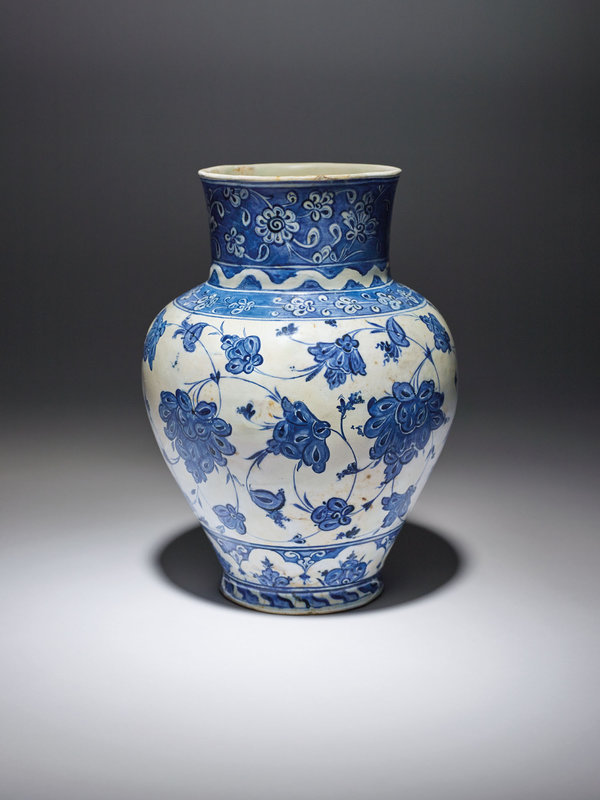

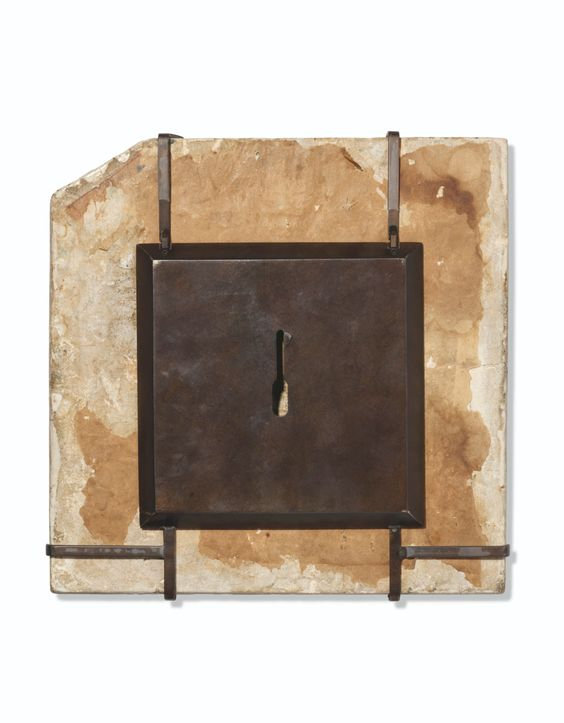
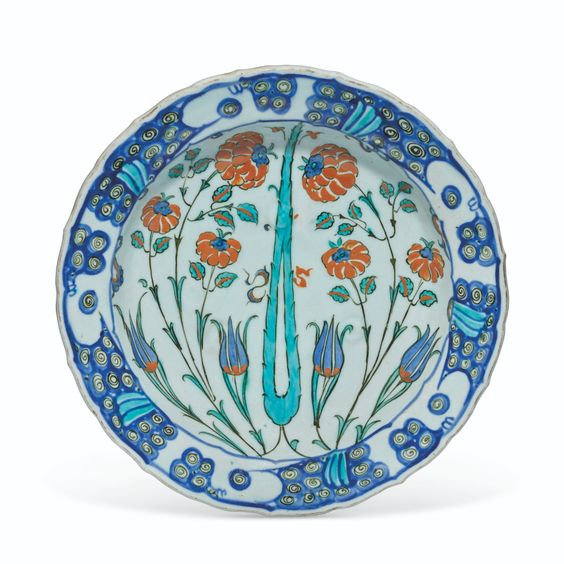

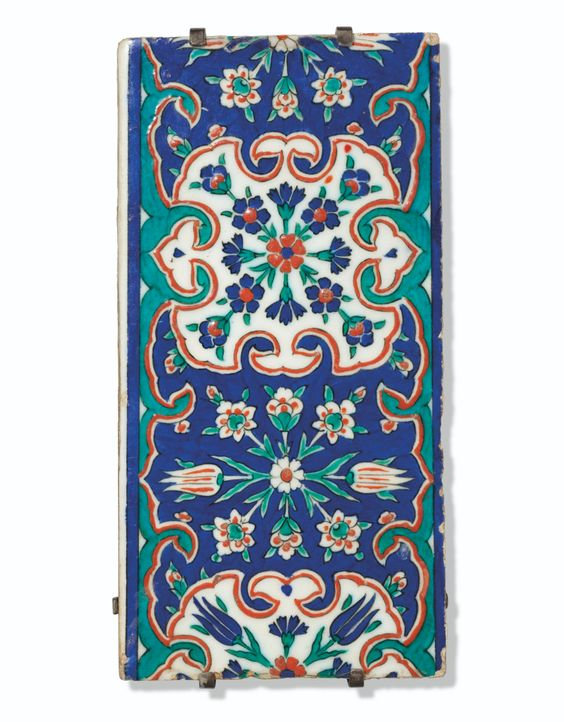
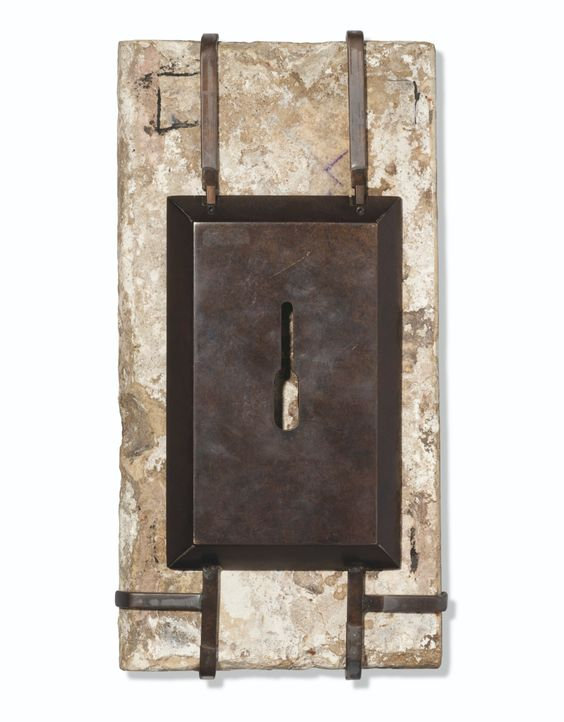
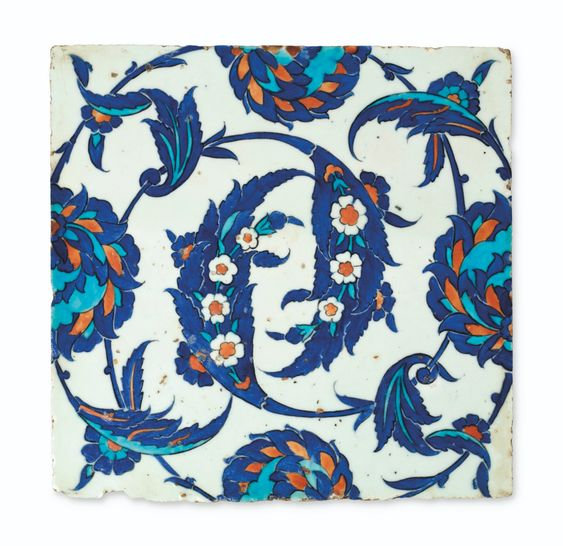
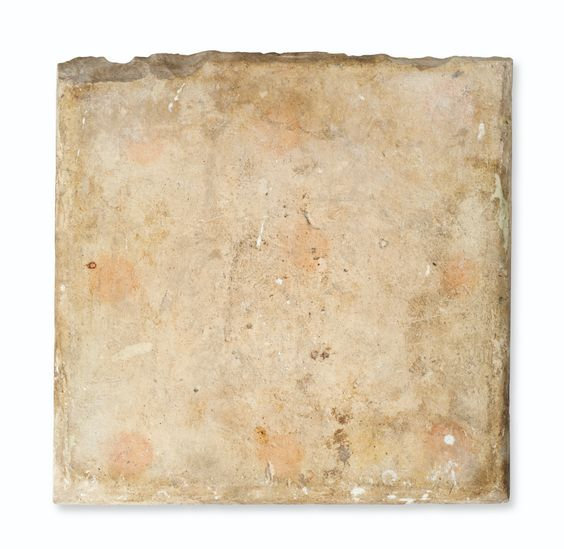

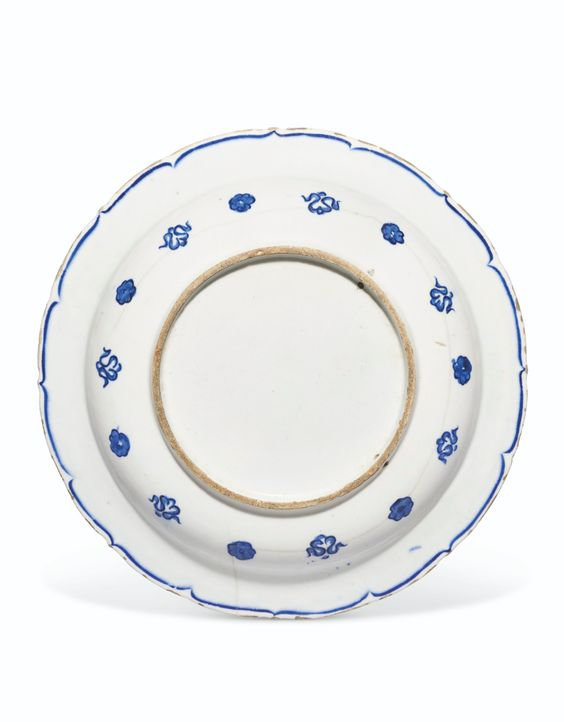

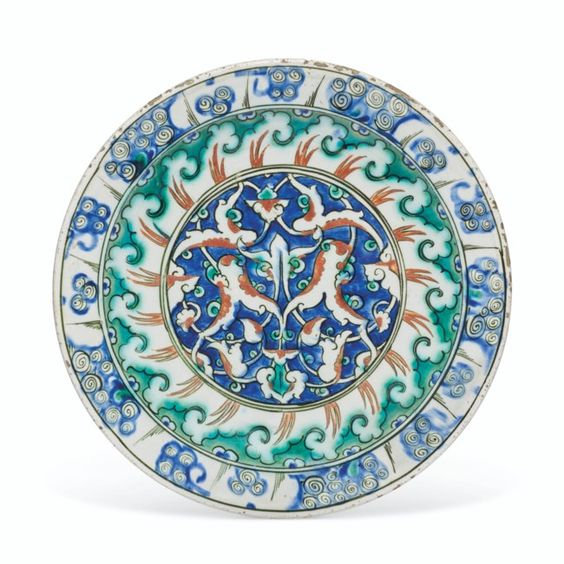



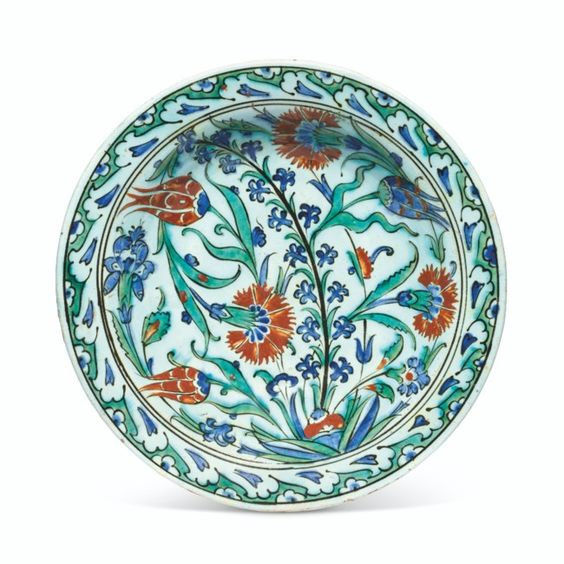
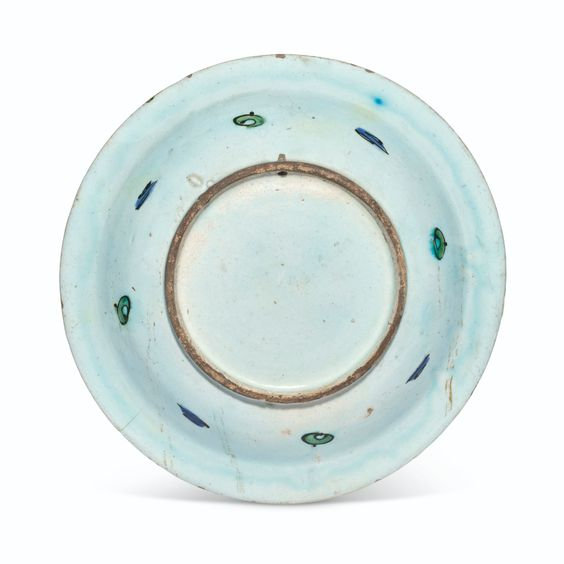

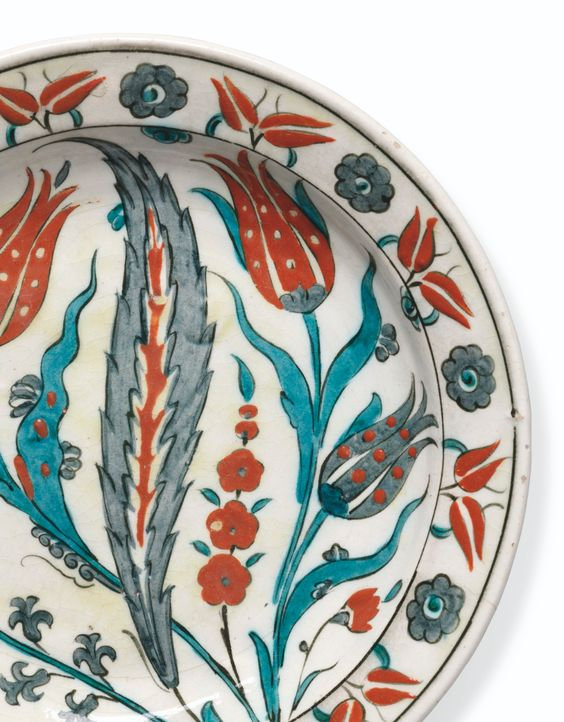


/image%2F1371349%2F20240315%2Fob_244543_433273530-1633376087432404-55342065241.jpg)
/http%3A%2F%2Fstorage.canalblog.com%2F06%2F13%2F119589%2F128980288_o.jpg)
/http%3A%2F%2Fstorage.canalblog.com%2F07%2F59%2F119589%2F128980194_o.jpg)
/http%3A%2F%2Fstorage.canalblog.com%2F13%2F62%2F119589%2F128980076_o.jpg)